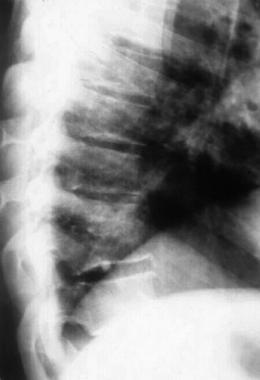

General recommendations and organism-specific therapeutic regimens for osteomyelitis (as shown in the radiograph below) are provided. However, treatment of bone infections can quickly become complicated, and significant morbidity and loss of function can result from failure to treat infections appropriately. It is recommended that consultation with an infectious diseases and orthopedic specialist be obtained to assist in management.
 Osteomyelitis of T10.
Osteomyelitis of T10.
Antibiotic therapy for hematogenous osteomyelitis should be pathogen-directed, based on the results of cultures from bone biopsy and/or blood cultures.
For osteomyelitis from contiguous spread of infection, wound culture is poorly correlated with bone biopsy culture for all organisms except methicillin-resistant Staphylococcus aureus (MRSA); unless MRSA is grown, surgical bone biopsy is recommended to define the correct pathogen.
Orthopedic surgical debridement and drainage is a mainstay of therapy and is necessary to remove sequestrum and prevent chronic osteomyelitis and disease recurrence.
For MRSA, a minimum of 8 weeks of antibiotic therapy is recommended. While parenteral therapy or antibiotics with high oral bioavailability is preferred, oral therapy at the end of the course can be used depending on the severity of the disease.
For MRSA, new data suggest that organisms with a vancomycin minimum inhibitory concentration (MIC) of 2 µg/mL or greater have a greater rate of treatment failure with vancomycin therapy. In this situation, an alternative agent such as daptomycin should be used.
For non-MRSA disease, 4-6 weeks of intravenous therapy or therapy with drugs with high oral bioavailability is preferred. However, a longer course may be indicated in any type of more complicated disease.
Chronic osteomyelitis with multiple recurrences of disease in the same location with the same organism, usually S aureus, may require extensive debridement followed by a prolonged intravenous antibiotic course up to 8 weeks for cure; however, failing this, lifelong suppression may be needed.
Treatment of osteomyelitis in conjunction with an infected orthopedic device is complicated and often requires a surgical resection of the device or a very prolonged course if the device is retained (and sometimes lifelong antibiotic suppression if further surgical manipulation can result in significant morbidity and loss of function). Appropriate consultation with an infectious diseases specialist and an orthopedic surgeon both with experience in dealing with infected prostheses is highly recommended.
Vertebral osteomyelitis infections involving infected neurosurgical or orthopedic hardware often require a course of intravenous therapy from 2-8 weeks followed by 1-2 years of long-term oral suppression in order to allow the vertebral bones to heal enough so that they will be stable enough for another washout or hardware resection if disease recurs.
Owing to the high rates of development of resistance to treatment, rifampin should never be used alone to treat S aureus.
Similarly, owing to the risk of development of resistance when there is a high burden of disease, trimethoprim-sulfamethoxazole should not be used as initial therapy alone for S aureus, even when the isolate is sensitive to trimethoprim-sulfamethoxazole; it should only be used after any necessary debridement of disease occurs and at least a 1- to 2-week course of treatment with another antibiotic.
Aminoglycosides generally have poor bone penetration and should only be used if all other antibiotic options are unavailable; however, they can theoretically be used synergistically to improve the bactericidal activity of beta-lactam antibiotics, vancomycin, and daptomycin in streptococcal and enterococcal infections, though clinical data are lacking.
As with any prolonged course of antibiotic treatment, monitoring for adverse effects is appropriate, and drug level monitoring of vancomycin and, in particular, aminoglycosides is necessary to avoid toxicity and maintain efficacy.
Long-term toxicities should be taken into account before any prolonged antibiotic course. Of particular concern are the following:
Methicillin-sensitive S aureus [1, 2, 3, 4, 5, 6]
Preferred:
Patients with penicillin allergy:
Oral therapy (to be used after an appropriate course of intravenous therapy only and if sensitivity testing suggests these agents will be effective):
MRSA [1, 5, 7, 8]
Preferred:
Alternative based on results of sensitivity testing and intolerance of agents above:
Oral therapy based on results of sensitivity testing:
Coagulase-negative staphylococci [5]
Preferred:
Oral therapy based on results of sensitivity testing:
Penicillin-sensitive streptococci [1, 5, 8]
Preferred:
Patients with penicillin allergy:
Oral therapy:
Intermediately sensitive streptococci (penicillin MIC ≥0.5) [1, 5, 8]
Oral therapy:
Enterococci [1, 5, 8]
Oral therapy:
Gram-negative bacilli (other than Pseudomonas) [1, 5, 8]
Oral therapy:
Pseudomonas aeruginosa [1, 5, 8]
Oral therapy:
Anaerobes [1, 5, 8]
Newer agents for gram-positive organisms [9, 10, 11, 12, 13]
The following agents could theoretically be used to treat osteomyelitis caused by MRSA and other gram-positive organisms, though at present, there are no good data on their use. There are more anecdotal reports of ceftaroline and telavancin being used with reportedly good results, but reporting bias could be taking place.
In view of their very long half-lives, dalbavancin and oritavancin could be very useful in treating osteomyelitis for a long course, but there currently are no good data to support their use, and therefore these drugs should be used only as a last resort. There are no known data regarding the use of tedizolid for osteomyelitis, though the oral dosing and good bioavailability make this an attractive option that is similar to linezolid but has the same poor side-effect profile.
Newer agents for highly resistant gram-negative organisms
Theoretically, the following antibiotics could be used to treat osteomyelitis when caused by a highly resistant gram-negative organism that is resistant to all other antibiotics; however, they should be used only as a last resort, given that there are absolutely no data regarding efficacy in the treatment of osteomyelitis or the increased likelihood of adverse effects with long-term administration.
Copyright © www.orthopaedics.win Bone Health All Rights Reserved